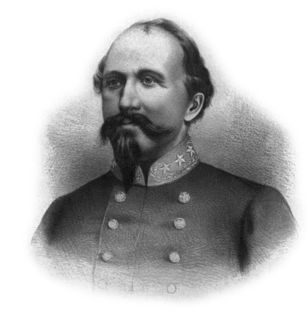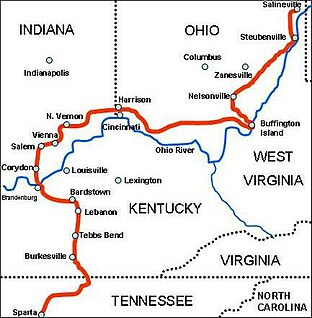
The Confederate States of America (CSA), commonly referred to as the Confederate States or the Confederacy, was an unrecognized breakaway state that existed from February 8, 1861, to May 9, 1865, and that fought against the United States of America during the American Civil War. The eleven states that seceded from the Union and formed the main part of the CSA were South Carolina, Mississippi, Florida, Alabama, Georgia, Louisiana, Texas, Virginia, Arkansas, Tennessee, and North Carolina.

Memorial Day is a federal holiday in the United States for honoring and mourning the U.S. military personnel who have died in the performance of their military duties. The holiday is observed on the last Monday of May. The holiday was observed on May 30 from 1868 to 1970.

Juneteenth is a federal holiday in the United States commemorating the emancipation of enslaved African Americans. It is also often observed for celebrating African-American culture. Originating in Galveston, Texas, it has been celebrated annually on June 19 in various parts of the United States since 1866. The day was recognized as a federal holiday on June 17, 2021, when President Joe Biden signed the Juneteenth National Independence Day Act into law. Juneteenth's commemoration is on the anniversary date of the June 19, 1865, announcement of General Order No. 3 by Union Army general Gordon Granger, proclaiming and enforcing freedom of enslaved people in Texas, which was the last state of the Confederacy with institutional slavery.

Confederate Memorial Day is a cultural holiday observed in several Southern U.S. states on various dates since the end of the Civil War to remember the estimated 258,000 Confederate soldiers who died in military service.

John H. Morgan was a Confederate general in the American Civil War of 1861-1865.

In the context of the American Civil War (1861–65), the border states were slave states that did not secede from the Union. They were Delaware, Maryland, Kentucky, and Missouri, and after 1863, the new state of West Virginia. To their north they bordered free states of the Union and to their south they bordered slave states of the Confederacy.

In the United States before 1865, a slave state was a state in which slavery and the slave trade were legal, while a free state was one in which they were not. Between 1812 and 1850, it was considered by the slave states to be politically imperative that the number of free states not exceed the number of slave states, so new states were admitted in slave–free pairs. There were, nonetheless, some slaves in most free states up to the 1840 census, and the Fugitive Slave Act of 1850 specifically stated that a slave did not become free by entering a free state.

Kanawha was a proposed name for the 39 counties which later became the main body of the U.S. state of West Virginia, formed on October 24, 1861. It consisted of most of the far northwestern counties of Virginia, which voted to secede from the state after Virginia joined the Confederate States of America at the beginning of the American Civil War on April 17, 1861.

Morgan's Raid was a diversionary incursion by Confederate cavalry into the northern (Union) states of Indiana, Kentucky, Ohio and West Virginia during the American Civil War. The raid took place from June 11 to July 26, 1863, and is named for the commander of the Confederate troops, Brigadier General John Hunt Morgan. Although it caused temporary alarm in the North, the raid was ultimately classed as a failure.

West Virginia is one of two American states formed during the American Civil War (1861–1865), along with Nevada, and is the only state to form by seceding from a Confederate state. It was originally part of the British Virginia Colony (1607–1776) and the western part of the state of Virginia (1776–1863), whose population became sharply divided over the issue of secession from the Union and in the separation from Virginia, formalized by West Virginia's admittance to the Union as a new state in 1863. West Virginia was one of the Civil War Border states.
The Battle of Salineville occurred July 26, 1863, near Salineville, Ohio during Morgan's Raid in the American Civil War. Except for the St. Albans (Vermont) Raid, it was the northernmost military action involving the Confederate States Army. The Union victory shattered John Hunt Morgan's remaining Confederate cavalry and led to his capture later that day.

The U.S. state of West Virginia was formed out of western Virginia and added to the Union as a direct result of the American Civil War, in which it became the only modern state to have declared its independence from the Confederacy. In the summer of 1861, Union troops, which included a number of newly-formed Western Virginia regiments, under General George McClellan, drove off Confederate troops under General Robert E. Lee. This essentially freed Unionists in the northwestern counties of Virginia to form a functioning government of their own as a result of the Wheeling Convention. Prior to the admission of West Virginia the government in Wheeling formally claimed jurisdiction over all of Virginia, although from its creation it was firmly committed to the formation of a separate state.

During the American Civil War, the State of Ohio played a key role in providing troops, military officers, and supplies to the Union army. Due to its central location in the Northern United States and burgeoning population, Ohio was both politically and logistically important to the war effort. Despite the state's boasting a number of very powerful Republican politicians, it was divided politically. Portions of Southern Ohio followed the Peace Democrats and openly opposed President Abraham Lincoln's policies. Ohio played an important part in the Underground Railroad prior to the war, and remained a haven for escaped and runaway slaves during the war years.

Virginia became a prominent part of the Confederacy when it joined during the American Civil War. As a Southern slave-holding state, Virginia held the state convention to deal with the secession crisis, and voted against secession on April 4, 1861. Opinion shifted after April 15, when U.S. President Abraham Lincoln called for troops from all states still in the Union to put down the rebellion, following the capture of Fort Sumter. The Virginia convention voted to declare secession from the Union on April 17. A Unionist government was established in Wheeling and the new state of West Virginia was created by an act of Congress from 50 counties of western Virginia, making it the only state to lose territory as a consequence of the war.
The Staunton-Parkersburg Turnpike was built in what is now the U.S. states of Virginia and West Virginia during the second quarter of the 19th century to provide a roadway from Staunton, Virginia and the upper Shenandoah Valley to the Ohio River at present-day Parkersburg, West Virginia. Engineered by Claudius Crozet through the mountainous terrain, it was a toll road partially funded by the Virginia Board of Public Works. Control of this road became crucial during the American Civil War. Today, the Staunton-Parkersburg Turnpike can be largely traversed by following West Virginia Route 47 east from Parkersburg to Linn, then U.S. Route 33 east through Weston and Buckhannon to Elkins, then U.S. Route 250 southeast through Beverly, Huttonsville, crossing the West Virginia/Virginia state line to Staunton, Virginia.

The RestoredGovernment of Virginia was the Unionist government of Virginia during the American Civil War (1861–1865) in opposition to the government which had approved Virginia's seceding from the United States and joining the new Confederate States of America. Each government regarded the other as illegitimate; the Restored Government had de facto control of the state's northwest until, with its approval, the area became West Virginia in mid-1863. Since the Restored Government and West Virginia mutually recognized each other, the former government thereafter became in large part a government in exile. Until the end of hostilities, most of its de jure territory remained controlled by the secessionist state government, which never recognized either Unionist state government operating within its antebellum borders. Furthermore, since the Restored Government's claimed territory not under secessionist control only remained so by force of arms it was placed under Federal martial law, thus further limiting the authority of the Unionist civilian government.
The Jones–Imboden Raid was a Confederate military action conducted in western Virginia in April and May 1863 during the American Civil War. The raid, led by Brig. Gens. William E. Jones and John D. Imboden, was aimed at disrupting traffic on the vital Baltimore and Ohio Railroad and reasserting Confederate authority in transmountain Virginia in an effort to derail the growing statehood movement in the region, since voters had in March approved a new Constitution and statehood only awaited Congressional and Presidential approval.

Charles James Faulkner was a politician, planter, and lawyer from Morgan County, Virginia who served in both houses of the Virginia General Assembly and as a U.S. Congressman.
On June 20, 1863 the U.S. government created a new state from 50 western counties of Virginia to be named "West Virginia". This was done on behalf of a Unionist government in Wheeling, Virginia, approved by Congress and President Lincoln, though it was done with a low participation of the citizens within the new state. There remained a large number of counties and citizens who still considered themselves as part of Virginia and the Confederacy which, in turn, considered the new state as part of Virginia and the Confederacy. In 1861 the 50 counties contained a population of 355,823 whites, 2,782 freemen, 18,371 slaves, 79,515 voters and 67,721 men of military age. West Virginia was the 6th most contested state during the war, with 632 battles, engagements, actions and skirmishes.














